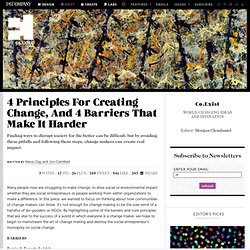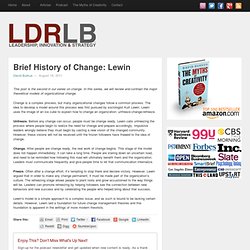

4 Principles For Creating Change, And 4 Barriers That Make It Harder. Many people now are struggling to make change; to drive social or environmental impact whether they are social entrepreneurs or people working from within organizations to make a difference.

In this piece, we wanted to focus on thinking about how communities of change makers can thrive. It’s not enough for change making to be the sole remit of a handful of do-gooders or NGOs. By highlighting some of the barriers and core principles that are vital to the success of a world in which everyone is a change maker, we hope to begin to mainstream the art of change making and destroy the social entrepreneur’s monopoly on social change.
Barrier 1: Experts As Idols Too often change making is outsourced to experts or social entrepreneurs rather than community members. Barrier 2: Conditions Of Problem Solving Are Overlooked Much of the time, we are quick to jump to tactical problem solving without fully reflecting on whether the conditions for it are put in place. Free Organizational Change Resources. Life Changing: A Philosophical Guide. The world is changing.

Are you ready for the opportunities? Life Changing is a hands-on guide to harnessing the power of change. Using philosophical examples, it shows you how to cultivate the resilience, agility and vision to embrace change and make it an adventure. The book includes practical exercises that show you how to apply the ideas in familiar contexts. By doing the exercises, you learn how to think philosophically about change and unleash its life changing possibilities. Be creative with change. Life Changing is available on Amazon, Kobo, and iTunes.
Download a FREE PDF copy of Life Changing here. Listen to Tim Rayner talk to Sophie Longdon on ABC Radio, Australia. Www.cemerdemir.com/ManageChange.pdf. Lewin's Change Management Model - Change Management Training from MindTools. Understanding the Three Stages of Change Find out about Lewin's Change Management Model, in this short video.

Change is a common thread that runs through all businesses regardless of size, industry and age. Our world is changing fast and, as such, organizations must change quickly too. Organizations that handle change well thrive, whilst those that do not may struggle to survive. The concept of "change management" is a familiar one in most businesses today. One of the cornerstone models for understanding organizational change was developed by Kurt Lewin back in the 1950s, and still holds true today.
Understanding Lewin's Model If you have a large cube of ice, but realize that what you want is a cone of ice, what do you do? By looking at change as process with distinct stages, you can prepare yourself for what is coming and make a plan to manage the transition – looking before you leap, so to speak. Unfreeze This first part of the change process is usually the most difficult and stressful. Lewin's Force Field Analysis Explained. Kurt Lewin's Force Field Analysis is a powerful strategic tool used to understand what's needed for change in both corporate and personal environments.

Best of all - it's easy to use and has complete credibility as a professional tool. We'll use a little basic science to introduce the concept, after which you'll find enough information to allow you to unleash your knowledge of force fields on colleagues! You can download this free Application Tool when you're ready. You will need Adobe Reader to open the file. The Concept Let's start with a simple science experiment (this really is relevant, so stay with me for a moment please). You'll need to sit down for this one. Well, there are two answers really. The other is the chair itself, which provides an opposing force, pushing up against gravity, and stopping you falling to the ground. So it would seem that while you are sitting you're in an equilibrium of sorts. Two forces keep you there. Agreed? May the Force be with you, or against you.
Brief History of Change: Lewin - LeaderLab. This post is the second in our series on change.

In this series, we will review and contrast the major theoretical models of organizational change. Change is a complex process, but many organizational changes follow a common process. The idea to develop a model around this process was first pursued by sociologist Kurt Lewin. Change Theory by Kurt Lewin.
Kotter 8-Step Change model.